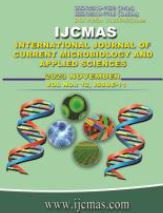


 National Academy of Agricultural Sciences (NAAS)
National Academy of Agricultural Sciences (NAAS)

|
PRINT ISSN : 2319-7692
Online ISSN : 2319-7706 Issues : 12 per year Publisher : Excellent Publishers Email : editorijcmas@gmail.com / submit@ijcmas.com Editor-in-chief: Dr.M.Prakash Index Copernicus ICV 2018: 95.39 NAAS RATING 2020: 5.38 |
Package of practices for highly Calcareous soils were developed, tested and validated to supply optimum NPKSZn and B content in index leaf of Bt hybrid cotton during boll formation stage, such as seed treatment (S.Tr) with NPK consortia soil having Azotobacter sp. strain MTCC-3853 + Rhizobium leguminoserum- strain MTCC-99 + PSB: Bacillus megatherium var. phosphaticum strain MTCC-24121, MTCC 2412, Bacillus licheniformis strain-MTCC-2312, Bacillus subtilis strain MTCC-736 + KMB: K mobilising bacteria Acido thiobacillus ferroxidans strain: 5370; Pseudomonas fluorescens migula: strain 2659 to encourage soil biological activities in low OC soil along with 75% RDF only. Bentonite sulphur 20 kg ha-1 soil application (SA) + RDF; Sagarika S. Tr along with twice foliar sprays (FS) at squaring and flowering + RDF; Nano ZnO 4% S. Tr. twice FS + RDF during 2019, exception was during 2020, the magnitude was 50% less due twice torrential and 5 times medium rains during July and August months upset the physiology of cotton, shedded all the fruiting bodies, unable to maintain index leaf NPK, besides heavy pink bollworm attack. All these treatments were applied with 100% RDF granular, split, spot application having 6.5%Sulphur containing, N: P2O5: K2O @ 22.5 kg ha-1 twice on 15, 30 DAS and twice as Urea at 45 and 60 DAS, Bentonite Sulphur 20 kg ha-1 or seed treatment and foliar applications of bio-stimulants Sagarika @ 0.02% and twice foliar applications of the same @ 0.002% and Nano ZnO @ 0.004% twice produced 67-86 ppm Zn in index leaf of the Bt hybrid cotton, similar to that of chelated Zn 0.5%. This POPs produced 161-287 kg lint ha-1 i. e. more than double 38 to 50% due to better nutrient uptake, biomass production, boll number with more than INRs. 16 to 30, 000/- ha-1 profitability and 1.59 to 2.15 C:B ratio, FUE 1.6 to 1.2 and lowest cost of production in both the years. Large scale OFTs in Kalmeshwar Tq, Nagpur district (M.S.) India in highly Calcareous soils, confirmed the beneficial effect of soil application of Bentonite sulphur or sulphur containing complex fertilizers @ RDF with and without two winter irrigations in late September besides seed treatment with PGPRs or Bio-stimulants before sowing and twice foliar applications at squaring and flowering stages with ZnSO4 0.5% or nano ZnO 4% 0.004% or Bio-stimulants 28% 0.002% along with Urea 2% and Boron 0.3% or cheleted micronutrients 0.5% along with WSF 17:44:0 and 0:0:50 2.0% in doubling the seed cotton yields besides reducing pre mature leaf reddening by maintaining optimum index leaf nutrient content with 40 bolls plant -1.
 |
 |
 |
 |
 |